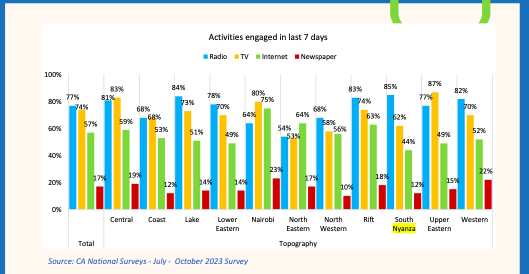The rate of radio consumption is higher in South Nyanza followed by Lake and the Rift regions, while North Eastern records the lowest listenership, the Communication Authority of Kenya says in its Kenya Media Landscape Report for July-September 2023.
- •Swahili is the most common language followed by vernacular.
- •According to the CAK, Swahili stations have a higher listenership in the Western and Coast topographies.
- •Listenership of vernacular stations is highest in the Lake and Lower Eastern topographies.
“Radio and television viewership surpasses other communication mediums in all regions except the North Eastern region, where internet usage takes the lead. Meanwhile, newspaper readership reaches its peak in the Nairobi and Western regions,” said the CAK.

Though South Nyanza leads, listenership is reported as tight in five regions with a marginal difference. 81 per cent of those sampled in Central part of the country prefer radio to other media outlets, Rift Valley commands 83 per cent listenership while Lake, Western and South Nyanza listenership is at 84, 82 and 85 per cent respectively.
North Eastern, where radio listenership is lowest at 54 per cent, recorded leads in internet usage at 64 per cent though after Nairobi region where 75 per cent of the sampled population use internet. South Nyanza, which leads in radio consumption, has the lowest internet usage at 44 per cent of the population surveyed followed by Lower and Upper Eastern at 49 per cent.
“There are more males who read newspapers as compared to females. In terms of age, readership is fairly similar. Higher readership incidences are reported in Nairobi and Western topographies and also in urban areas.”
- •Television medium remains favourite platform for brands placement, as out of Sh16 billion industry advertisement budget between July-September 2023, Sh10.9 billion was channeled to television stations.
- •Radio followed at Sh3.6 billion and another Sh1.6 billion was spent on print advertisement,
- •The count for radio stations surged from 120 to 228, and TV stations increased from 9 to 182, between 2015 and 2022.
The surge in TV stations can be attributed to the proliferation of digital media, with an increasing availability of stations across various platforms, including set-top-boxes and online streaming. The shift in consumption patterns has played a pivotal role in shaping the current media landscape.
Media Ad Spend Hits KSh 16 Billion, Television Takes Lion’s Share – Kenyan Wallstreet





